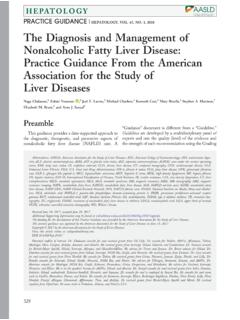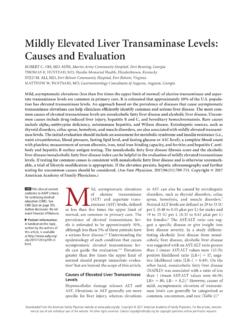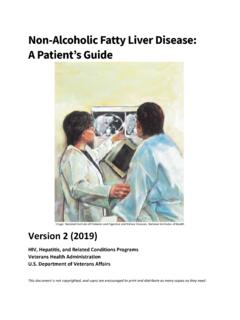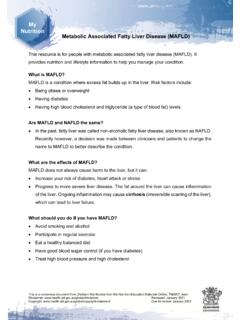Transcription of Cirrhosis and Chronic Liver Failure: Part I. Diagnosis and ...
1 Cirrhosis and Chronic Liver Failure: Part I. Diagnosis and Evaluation JOEL J. HEIDELBAUGH, , and MICHAEL BRUDERLY, University of Michigan Medical School, Ann Arbor, Michigan Cirrhosis and Chronic Liver failure are leading causes of morbidity and mortality in the United States, with the majority of preventable cases attributed to excessive alcohol consumption, viral hepatitis, or nonalcoholic fatty Liver disease . Cirrho- sis often is an indolent disease ; most patients remain asymptomatic until the occurrence of decompensation, character- ized by ascites, spontaneous bacterial peritonitis, hepatic encephalopathy, or variceal bleeding from portal hypertension. Physical examination of patients with Cirrhosis may reveal a variety of findings that necessitate a hepatic- or gastro- intestinal-based work-up to determine the etiology.
2 Some patients already may have had laboratory or radiographic tests that incidentally uncovered signs of Cirrhosis and its comorbidities. No serologic or radiographic test can accurately diagnose Cirrhosis . A significant corre- lation has been demonstrated between persistently elevated Liver func- tion tests and biopsy-proven underlying hepatic disease ; thus, a more targeted serologic work-up is indicated in patients whose Liver function test results are persistently abnormal. Unnecessary medications and surgical procedures should be avoided in patients with Cirrhosis . Refer- ILLUSTRATION BY FLOYD E. HOSMER. ral for Liver biopsy should be considered only after a thorough, non- invasive serologic and radiographic evaluation has failed to confirm a Diagnosis of Cirrhosis ; the benefit of biopsy outweighs the risk; and it is postulated that biopsy will have a favorable impact on the treatment of Chronic Liver disease .
3 (Am Fam Physician 2006;74:756-62,781. Copy- right 2006 American Academy of Family Physicians.). C. This is part I of a two-part irrhosis and Chronic Liver fail- as nonalcoholic steatohepatitis, or NASH). article on Cirrhosis and ure together were the 12th most is an increasingly common cause of Liver Chronic Liver failure. Part II, Complications common cause of death in the injury; risk factors include obesity, diabetes, and Treatment, appears United States in 2002, accounting hypertriglyceridemia, and profound weight in this issue of AFP on for 27,257 deaths ( per 100,000 persons), loss after jejunoileal page 767. with a slight male Approxi- According to estimates from the United Patient information.
4 Mately 40 percent of patients with Cirrhosis Network for Organ Sharing, 75 to 80 per- A handout on Cirrhosis and are asymptomatic, and the condition often cent of Cirrhosis cases could be prevented by Chronic Liver failure, writ- ten by the authors of this is discovered during a routine examination eliminating alcohol abuse, and approximately article, is on page 781. with laboratory or radiographic studies, or at million Americans have Chronic hepati- autopsy. In 2000, there were 360,000 hos- tis In August 2005, there were 17,935 per- pital discharges related to Cirrhosis and Liver sons with Cirrhosis (from various etiologies). This article, part I of a two-part series, in the United States who were awaiting a Liver outlines the Diagnosis and evaluation of cir- Mortality rates in patients with rhosis and Chronic Liver failure (Figure 1).
5 Part alcoholic Liver disease are considerably higher II discusses complications and than in patients with other forms of Cirrhosis . Single or multifactorial insults to the Liver The Centers for disease Control and Preven- ultimately lead to Cirrhosis , the most com- tion estimates that 75,766 deaths and mil- mon being alcohol abuse, Chronic hepatitis C, lion years of potential life lost during 2001. and obesity with concomitant nonalcoholic were attributable to excessive alcohol use, an fatty Liver disease (Table 1).3,4 nonalcoholic average of approximately 30 years of potential fatty Liver disease ( nafld ; formerly known life lost for each alcohol-attributable Downloaded from the American Family Physician Web site at Copyright 2006 American Academy of Family Physicians.)
6 For the private, noncommercial use of one individual user of the Web site. All other rights reserved. Contact for copyright questions and/or permission requests. SORT: KEY RECOMMENDATIONS FOR PRACTICE. Evidence Clinical recommendation rating References Although no laboratory test can diagnose Cirrhosis accurately, Liver function tests, a complete blood count C 14. with platelets, and a prothrombin time test should be performed if a Liver abnormality is suspected. If clinical, laboratory, and radiographic data are inconclusive, but suspicion of Cirrhosis remains, C 15, 17. a diagnostic Liver biopsy should be performed. If serum transaminase levels are greater than twice the upper limit of normal or remain elevated for C 15.
7 Longer than six months, additional serologic studies should be performed to evaluate for various etiologies of Cirrhosis . If clinical suspicion for Liver disease is high, further serologic work-up is warranted earlier. Abdominal ultrasonography is a specific, reliable, noninvasive, fast, and cost-effective test that C 20, 21. should be used as a first-line radiographic study for diagnosing Cirrhosis . A = consistent, good-quality patient-oriented evidence; B = inconsistent or limited-quality patient-oriented evidence; C = consensus, disease - oriented evidence, usual practice, expert opinion, or case series. For information about the SORT evidence rating system, see page 699 or Diagnosis of Cirrhosis and Chronic Liver Failure History: Physical examination: Laboratory studies: Radiographic studies: Patient presents with signs and Patient has hallmark Patient has incidental Liver panel* Patient has incidental findings symptoms of Chronic Liver disease findings consistent with abnormalities ( , elevated ALT and/ suggestive of Liver disease on or has risk factors for Chronic Liver Chronic Liver disease or AST) or positive screen for serologic routine studies ( , abdominal disease ( , alcohol abuse, risk (see Table 2).))
8 Markers of Liver disease (see Table 3). ultrasonography, CT, MRI). of viral hepatitis, obesity). Physical examination findings Confirm history via signs Confirm history via signs and symptoms of consistent with Liver disease and symptoms of Chronic Chronic Liver disease and positive risk factors (see Table 2) or high suspicion Liver disease and positive risk ( , alcohol abuse, risk of viral hepatitis, for Chronic Liver disease factors ( , alcohol abuse, obesity) and screen for hallmark physical risk of viral hepatitis, obesity). examination findings (see Table 2). Obtain Liver panel* (if not already obtained), CBC with platelets, prothrombin time, and targeted serologic studies to determine etiology of Cirrhosis , highlighting risk factors and family history for Liver disease (see Table 3).
9 Obtain abdominal ultrasonography with Doppler (if not already performed) to evaluate for morphologic abnormalities consistent with Cirrhosis and to assess for potential complications ( , ascites, varices, portal hypertension, portal vein thrombosis). Refer for possible Liver biopsy if Diagnosis of Cirrhosis is uncertain, as well as possible determination of etiology via histology if not readily determinable through serologic testing and if potential benefit outweighs risk of procedure. * Tests included in standard Liver panels vary but typically include the serum enzymes ALT, AST, alkaline phosphatase, and g-glutamyltransferase;. total, direct, and indirect serum bilirubin; and serum albumin.
10 Figure 1. Algorithm for the Diagnosis of Cirrhosis and Chronic Liver failure. (ALT = alanine transaminase; AST = aspartate transaminase; CT = computed tomography; MRI = magnetic resonance imaging; CBC = complete blood count.). Definitions and Etiologies Injury to the Liver parenchyma associated with an influx The Liver aids greatly in the maintenance of metabolic of acute or Chronic inflammatory cells is termed hepatitis. homeostasis by processing dietary amino acids, carbohy- Cirrhosis refers to a progressive, diffuse, fibrosing, nodu- drates, lipids, and vitamins; metabolizing cholesterol and lar condition that disrupts the entire normal architecture toxins; producing clotting factors; and storing glycogen.

















